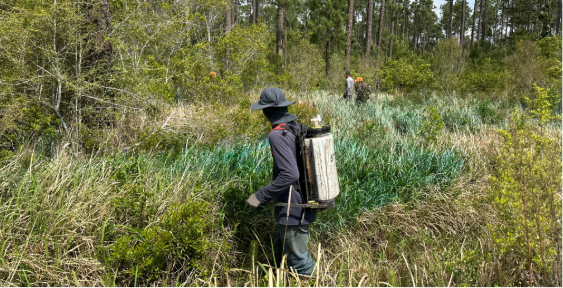AFM NEWS
Battling Invasive Species: Effective Strategies for Management in Forests

Invasive species pose a significant threat to forest ecosystems nationwide, competing with native flora for vital resources. While some invasive species may appear benign, many cause substantial damage, necessitating proactive management strategies. In southeastern Florida, foresters confront the challenges posed by three particularly troublesome invaders, demanding decisive action to curb their spread.
Identifying Key Invasive Species
Among the invasive species in Florida, cogon grass (Imperata cylindrica) stands out as a formidable adversary, earning its place among the “world’s most invasive weeds,” according to the US Department of Agriculture (USDA). Its aggressive rhizomatous roots suffocate neighboring plants, thriving in open areas disrupted by human activities. Additionally, the Chinese tallow tree (Triadica sebifera), initially introduced for ornamental purposes, has rapidly become a nuisance across wetlands and uplands alike. Recognizable by its heart-shaped leaves and distinctive wax-covered seeds resembling popcorn, its spread is facilitated by avian and water dispersal. Further exacerbating the situation is the Japanese climbing fern (Lygodium japonicum), a vine capable of scaling heights of up to 90 feet. It is particularly problematic in pine plantations managed for pine straw due to its affinity for disturbed environments. It can also be easily spread by unsuspecting homeowners when they purchase pine straw for landscaping.
Causes and Consequences of Spread
Invasive species often gain a foothold through human activities, whether introduced for ornamental purposes or inadvertently transported via equipment. Climate change exacerbates this issue, creating favorable conditions for invasive species expansion which disrupts native ecosystems. The consequences of inaction are dire, as evidenced by the 2023 wildfire in Maui, where invasive grasses, fueled by flash droughts and high winds, devastated native forests and historic towns alike, underscoring the urgent need for management strategies. While climate change is not the only factor, its contributions create conditions that worsen the outcomes of uncontrolled invasive species spread.
Effective Management Strategies
While the costs of controlling invasive species may seem daunting, the price of inaction far exceeds that of proactive intervention. Simple measures like mowing or cutting down invasive species often prove ineffective as they regrow vigorously from the remnants. Instead, targeted approaches such as forestry herbicides or controlled burns may offer more promising results (depending on the species), albeit requiring sustained efforts over the course of several years. Collaboration with organizations and landowners is essential, as some offer incentives for the removal of invasive species in favor of native flora, as in the case with the Bradford pear in North Carolina and South Carolina.
Empowering Landowners and Communities for Action
Beyond forestry management, community engagement plays a pivotal role in combating invasive species. Initiatives run by local organizations sponsor clean-up days and native tree-planting events, which foster a sense of stewardship among residents, empowering them to take proactive measures in their own neighborhoods. Simple actions like cleaning footwear before and after forest visits can also mitigate the accidental spread of invasive species, safeguarding local ecosystems.
In the battle against invasive species, prevention reigns supreme. By adopting proactive measures and leveraging collaborative efforts, we can stem the tide of invasive species expansion, safeguarding our forests, wildlife, and biodiversity for generations to come. For expert guidance and consultation, reach out to American Forest Management and let us help you protect your investment from invasive species.
